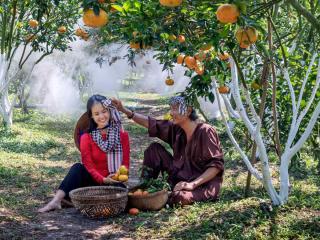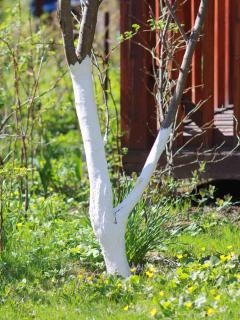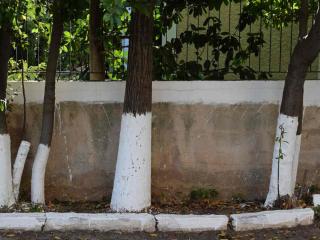

During a stroll in the countryside, you might have spotted an orchard with tree trunks painted white. This method, a natural alternative to pesticides for fruit trees, is called limewashing. It involves applying lime milk to tree trunks as a preventive measure against pests and diseases.
Limewashing means applying lime to tree, especially fruit trees trunks (or even ornamental trees).
You could of course use quicklime directly, but a preparation based on lime called lime milk, or more commonly tree whitening, is recommended as it’s less corrosive and dangerous.
This whitewash is made of powdered lime crust (a by-product of the thermal decomposition of limestone) mixed with water. It is a natural alternative to the use of chemical pesticides. Long used by previous generations, it’s making a comeback today due to its (almost) zero environmental impact. It can be used in organic farming.
 Limewashing fruit trees isn’t for aesthetic purposes as some might think! It’s primarily a preventive treatment against the ravages of certain insects or fungi, which are the main causes of fungal diseases. To put it simply, limewashing a tree helps sanitize it and protects it from the proliferation of parasites and diseases.
Limewashing fruit trees isn’t for aesthetic purposes as some might think! It’s primarily a preventive treatment against the ravages of certain insects or fungi, which are the main causes of fungal diseases. To put it simply, limewashing a tree helps sanitize it and protects it from the proliferation of parasites and diseases.
So, tree whitening is effective against:
Whitewashing trees involves several steps, starting with prep work for your trees.
 You can apply lime paint between September and April, but late winter is best because it’s a time when nature is waking up thanks to rising temperatures, especially bugs and fungal spores.
You can apply lime paint between September and April, but late winter is best because it’s a time when nature is waking up thanks to rising temperatures, especially bugs and fungal spores.
A February or March application works best. Make sure to put tree paint on trunks during a frost-free day, with no announced rain and no wind.
Tree whitewashing should be performed every 3 to 4 years.
Lather lime paint onto tree trunks, from the ground to the base of primary branches. Bark should be perfectly dry before application.
Before smearing tree trunks with lime paint, it’s key to prepare trees by scratching the bark first with a hard-bristle brush. This step helps eliminate moss and lichen, as well as dead bark pieces. After that, follow these steps strictly to avoid any risks:
 Wear tall gloves, boots, and goggles
Wear tall gloves, boots, and gogglesWhile whitewashing provides clear benefits, it also has a few negative consequences you should know about:
Want to learn more? Check these out:
where can i find this solution
will tree painting with lime stop codling moth lava climping up the tree